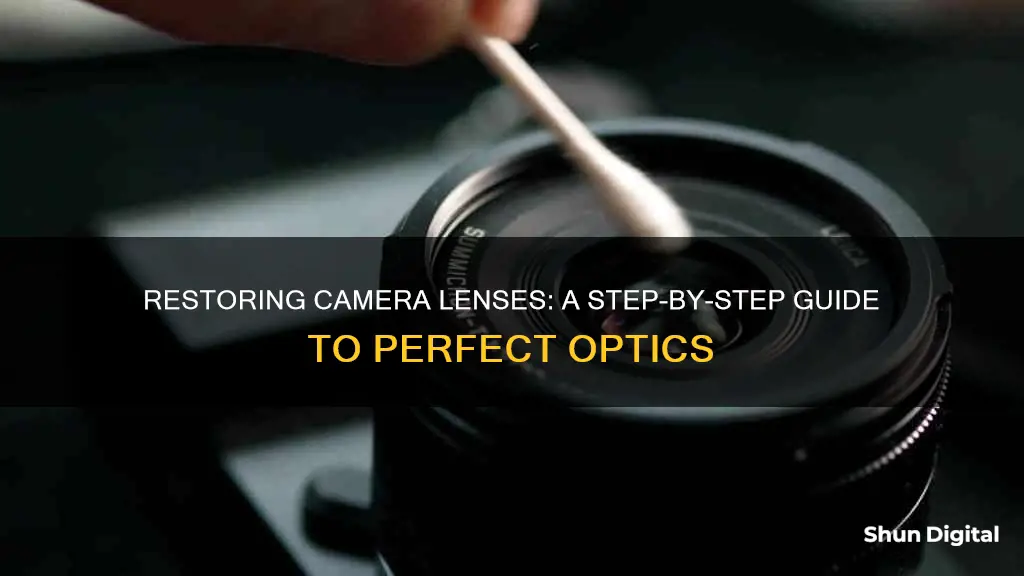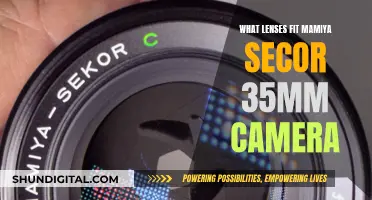
Camera lenses are notoriously fragile, so it's no surprise that camera lens repair issues are common for photographers. Most damage to lenses can be repaired, but it can be costly. Before attempting to restore a camera lens, it's important to identify the problem. This could be anything from a mechanical issue, such as a stuck zoom, to a software problem, like an error message or poor image quality. Once the issue has been identified, you can attempt to fix it yourself, but this is not recommended as you may end up causing further damage. It's usually best to seek the help of a professional, especially when it comes to the delicate internal elements of the lens. However, if you do wish to try a DIY fix, there are plenty of online guides and YouTube tutorials to help you get started.
| Characteristics | Values |
|---|---|
| Cleaning products | Windex, Naphtha, Distilled water, Denatured alcohol, Rubbing alcohol, Cotton swabs, Q-tips, Toothbrush, Toothpaste, Compressed air, Solvents, Scratch-removing wax, Polisher drill, Culture Hustle Black 2.0, Cotton swab |
| Common issues | Barrel distortion, Perspective distortion, Vignetting, Lens flare and ghosting, Chromatic aberration, E-18 lens error, Nikon Coolpix lens error, Sigma lens error 02, Sigma lens error 04, Sony camera lens error |
| Repair methods | Clean, Disassemble, Degrease, Re-lubricate, Repaint, Replace, Fine-tune, Update firmware, Calibration, Adjust aperture settings, Fix scratches, Remove fungus |
What You'll Learn

Cleaning the lens
The cleanliness of your camera lens affects the quality of your images. While it's important to keep your lens clean, it's also crucial to avoid over-cleaning, as this can lead to scratches and other types of damage. Here are some detailed, step-by-step instructions on how to effectively clean your camera lens:
Step 1: Use a blower to remove dust
Using a blower is the safest way to get rid of any dust and residue on your lens. Avoid blowing on the lens with your mouth, as your breath and saliva can increase condensation. Instead, opt for a plain blower or a brush blower without the brush attached. Gently squeeze the bulb and adjust the air pressure as needed to blow away any dust particles.
Step 2: Use a lens brush
If there are still some specs of dust or dirt on the lens, you can use a lens brush. It is recommended to use a lens brush with camel hair as it is thin and less likely to cause harm to the lens. Avoid touching the brush with your hands to prevent transferring oils onto the bristles, which could then be transferred to the lens.
Step 3: Use a lens cleaning solution
Using a lens cleaning solution is a last resort, as you want to minimise the risk of leaving streaks on the lens. Most solutions are alcohol-based, so only use one or two drops. Do not spray the cleaner directly onto the lens. Instead, apply the solution to a lens cleaning cloth or tissue.
Step 4: Wipe the lens with a cleaning cloth or tissue
When using a liquid lens cleaner, make sure to wipe it off with a microfiber lens cloth or specific lens cleaning tissues. Do not use regular tissues as they can scratch your lens. These specialised tissues are designed for one-time use, ensuring you avoid potential contamination from reuse. Washable microfiber cloths are also an option and can be reused, but make sure to keep them clean to prevent the transfer of dirt or grime.
Remember to only clean your lens when necessary. Your equipment will inevitably get a little dirty from time to time, but excessive cleaning can lead to more damage than the initial dirt or dust. Your camera lens is sensitive, so only clean it when required, and always be gentle.
Understanding Camera and Lens Lifespan by Shot Count
You may want to see also

Removing scratches
Before attempting to remove scratches from your camera lens, it's important to assess the severity of the damage. Minor surface scratches may not impact image quality and might not require repair. However, deep scratches or gouges can compromise image clarity and functionality.
Polishing kits and compounds:
Use a lens polishing kit with abrasive pads or discs of varying grit levels. Start with a coarse grit pad and gently rub the scratched area in a circular motion, applying light pressure. Gradually transition to finer grit pads to refine the surface and minimise scratches. Alternatively, use a polishing compound or solution specifically formulated for lens restoration. Apply a small amount to a soft, lint-free cloth and buff the scratched area gently.
Rubbing alcohol:
This method can be effective for minor scratches. Dampen a microfiber cloth with clinical-grade rubbing alcohol, being careful not to make the cloth too wet. Gently rub the scratch with the damp cloth. Be cautious, as rubbing alcohol can damage the lens coating.
Toothpaste:
Choose a coarse toothpaste with abrasive properties. Apply a small amount to a microfiber cloth and carefully work it onto the scratch. Toothpaste can also remove the lens coating, so proceed with caution.
Petroleum-based products:
Vaseline or other petroleum-based products can be used to remove scratches. Gently rub a small amount of the product onto the scratch with a microfiber cloth. This method is commonly used for repairing laptop screens.
Glass polish:
Use a windscreen polish designed for cars, which can be found at an auto body parts store. These polishes often have nano-glass coating protection and a low risk of harming your camera lens. Dampen a microfiber cloth with the product and rub it onto the scratch. This will also add a protective coating to your lens.
Eraser:
A soft, old-fashioned eraser can be used to "erase" minor scratches from your camera lens, as well as from phones and tablets.
Banana and baking soda:
Peel a banana and dip it in baking soda. Use the banana to gently wipe the scratch on the lens. This method carries a low risk of damaging the lens. However, be sure to clean the lens afterward to remove any residue.
Camera lens scratch repair kit:
Camera stores sell repair kits designed to remove scratches from lenses. These kits include a special cream that you apply to the lens and rub with a microfiber cloth until the scratches disappear. Deep scratches may take longer to improve.
It's important to exercise caution when attempting to remove scratches to avoid causing further damage. Some methods may remove the lens coating, so always test on a small area first. If you're unsure or the scratch is severe, consult a professional lens repair service.
Camera Lenses: Understanding the Basics of Photography
You may want to see also

Replacing the lens mount
The lens mount is one of the most vulnerable parts of a camera lens, and it can easily break if you accidentally drop the lens. The good news is that it is usually straightforward to replace, and replacement parts are typically affordable.
If you want to replace the lens mount yourself, you will need to search for instructions specific to your lens or brand. The process generally involves unscrewing the damaged part and screwing in the new one. However, it is important to keep the contact plate in place, as this is how the camera and lens communicate.
When to Seek Professional Help
While replacing a lens mount may seem simple, it is important to recognise when a problem is beyond your expertise. If your camera has been subjected to significant force, it is possible that the plastic to which the metal flange ring is attached has warped. In such cases, you may need to consult a specialist repair centre or a manufacturer service centre to realign the flange and sensor.
Cost of Professional Repair
The cost of repairing a lens mount can vary depending on the lens type and the service provider. For example, KEH CAMERA, a US-based store, charges USD$180 for repairing a non-professional fixed focal lens under 200mm, while a professional lens over 20mm will cost USD$320. Canon US offers free inspections and provides an estimate for any necessary repairs. Canon Europe and Canon Australia also provide online support and guidance for customers facing issues with their camera lenses.
Cleaning Camera and Binocular Lenses: A Step-by-Step Guide
You may want to see also

Checking for fungus
Lens fungus is a combination of dust and moisture that finds its way into the interior elements of a camera lens. It is more common with lenses used in very humid, tropical areas. It can look like small web-like spots or patches inside the lens. If left untreated, it can permanently decrease the performance of the lens and cause your images to look fuzzy or hazy.
- Remove the lens from the camera: Before beginning the inspection, take the lens off the camera.
- Uncap the lens: Ensure that both the front and rear lens caps are removed. This will allow you to examine the lens elements properly.
- Ensure adequate lighting: Make sure you have plenty of light near you. Bright light will help you see through the lens and identify any signs of fungus.
- Inspect the lens: Look through both ends of the lens, peering inside from the lens mount side. Check for any fuzzy spots, mycelial filaments, or web-like patches that indicate fungus growth. Shine a bright light through the lens and observe if there is any obstruction or discolouration within the lens.
- Compare with a new lens: If possible, compare the appearance of your lens with that of a new, fungus-free lens of the same model. This will help you identify any discrepancies or unusual spots that could be fungus.
- Seek professional evaluation: If you suspect the presence of lens fungus or are unsure, it is advisable to consult a professional lens technician. They can provide an accurate assessment and determine if cleaning or further action is required.
It is important to note that lens fungus is not typically covered under warranty, so prevention and regular inspection are crucial. To prevent fungus growth, store your lenses in a cool, dry place, and consider using silica gel packets to absorb moisture. Additionally, keep your lenses in a see-through container to allow light inside, as fungus thrives in dark environments.
The Camera Power of Note 8: How Many Lenses?
You may want to see also

Calibrating the lens
Calibrating your camera lenses is a simple process that can help you avoid blurry images. It involves fine-tuning the focus point of your images to ensure that your autofocused images are sharp. This process is especially important for DSLR cameras, as mirrorless cameras do not require lens calibration.
Step 1: Set Up Your Equipment
Place your camera on a tripod in a well-lit environment. You will also need a calibration chart, focus pyramid, or a DIY setup such as a hardcover book and a ruler. Set up your calibration subject on a flat surface, with your camera pointed at it. Adjust your camera settings to a shallow depth of field or the widest aperture possible, and set your shutter speed to the fastest setting that your lighting situation allows.
Step 2: Take Test Photos
Turn on autofocus and take a photo, focusing on the middle of your calibration subject. Compare your shot with how it looked in the viewfinder. If your image is blurry, determine whether it is back-focused or front-focused by checking where the focus falls on your calibration subject.
Step 3: Fine-Tune Your Focus
Access your camera's autofocus settings. If your focus is falling behind your centre subject (back focus), add a positive correction (+1 to +15). If your focus is falling in front of your centre subject (front focus), add a negative correction (-1 to -15).
Step 4: Repeat and Adjust
Continue taking test shots and adjusting your correction amount until your centre focus point is crisp both in your viewfinder and in your final image. This may take several attempts to get right.
It is important to note that different camera brands may have different names for the autofocus micro-adjustment tool. For example, in Nikon cameras, it is often called "AF fine-tune", while in Sony and Canon cameras, it is typically referred to as "AF micro-adjustment". Always refer to tutorials specific to your camera model before calibrating your lenses.
Additionally, it is recommended to calibrate your lenses periodically, depending on how much wear your equipment receives. For some, this may be every six months to two years for each camera and lens combination.
Samy's Camera: Renting Lenses and Photography Equipment
You may want to see also
Frequently asked questions
If you suspect something is wrong with your lens, start by researching online. Check the original website or press release for sample photos from the manufacturer, and visit forums where your lens is discussed to compare the quality of your images with those of other users. You can also visit a local photography store and ask to test the lens. If you notice any issues, run some tests: check for physical damage, scratches on the glass elements, and scratches on the lens body. Then, put your lens on the camera and do some test shots, checking for issues with autofocus, uneven focus, sharpness, excessive chromatic aberration, and vignetting.
Common issues with camera lenses include barrel distortion, perspective distortion, vignetting, lens flare and ghosting, and chromatic aberration.
First, determine the problem. If you're receiving an error message, try updating the firmware. If your images aren't sharp enough, your lens may need calibration. If you see halos or artefacts, you may have scratches on the front element. Send your lens for a professional inspection if you're unsure of the issue. You can also try cleaning your lens with a lens cleaning kit to remove any minor stains or marks.







